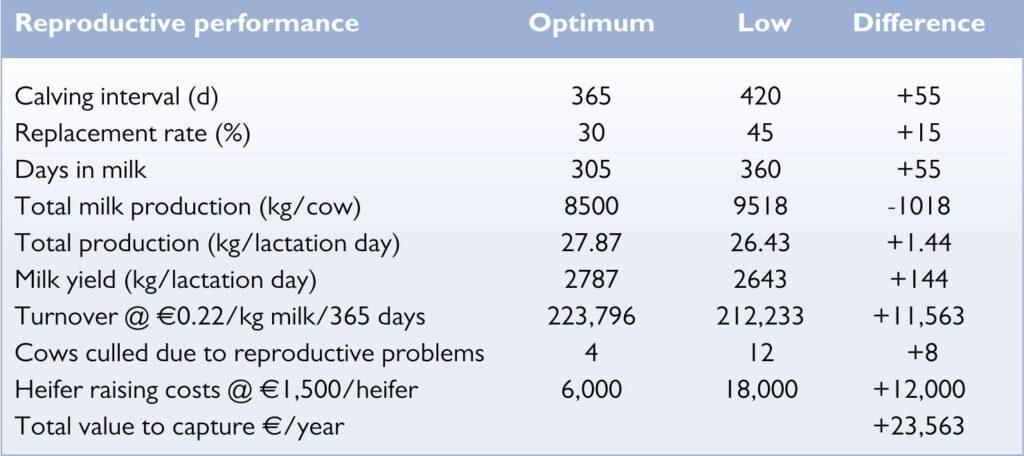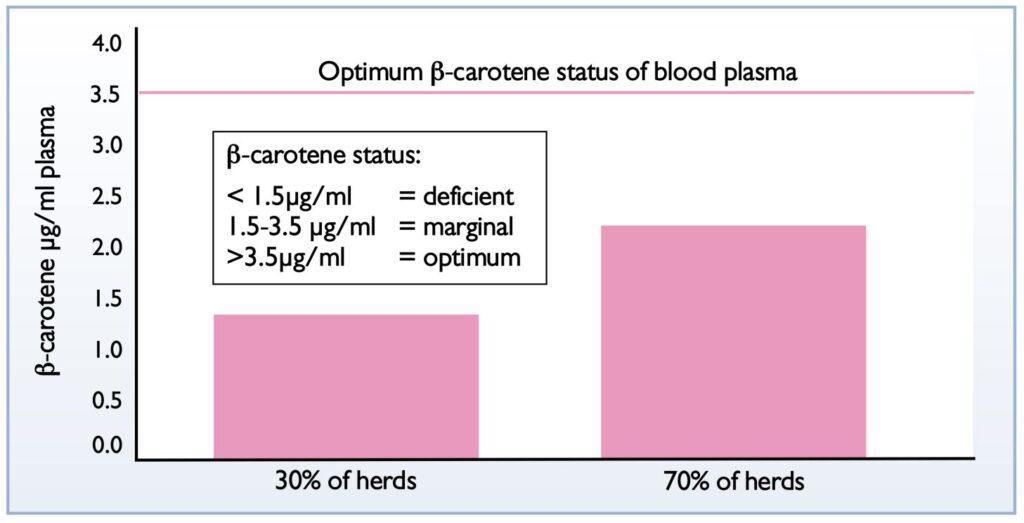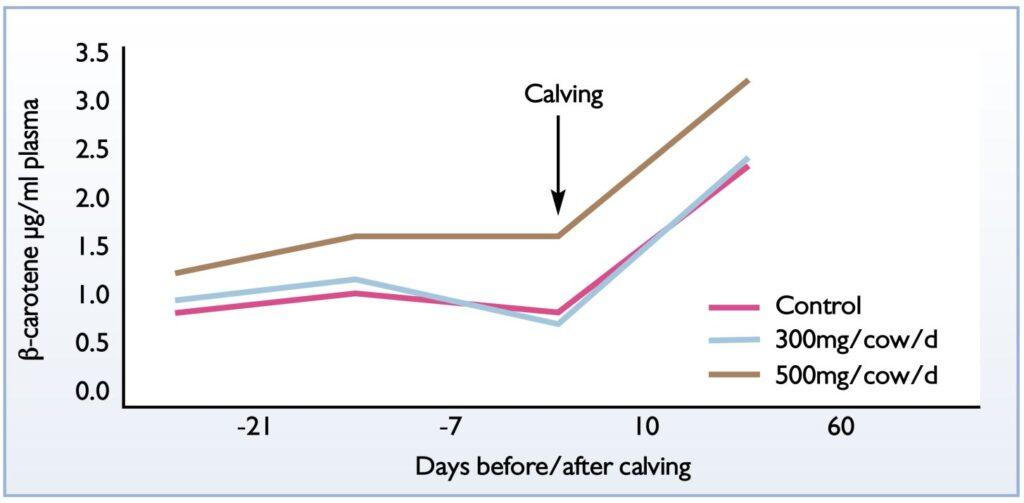by Dr Irmgard Immig,
DSM Nutritional Products,
PO Box 2676, Building 241/834,
CH-4002 Basel, Switzerland.
Cow numbers have decreased in many countries over the past 30 years whilst average milk yields have tended to rise. But this increased productivity has brought with it the negative trend of higher culling rates. USDA results from 2007 (Fig. 1) show 26% of cows leaving herds too early in their life are culled because of reproductive problems.

One of the most important of these problems with the modern dairy cow is the inability to rebreed after conception. This leads to long calving intervals and high herd replacement rates: major economic threats reducing the farmer’s monthly bottom line.
Calving intervals
Normally, a cow should calve once per year and herd replacement rate should not exceed 30%. Yet calving intervals of more than 420 days and replacement rates as high as 45% are reported in modern dairy herds. These factors of calving interval and parity are major drivers for profitability of milk production.
Cows with long calving intervals spend a higher percentage of time in late lactation when daily production can be no more than 18kg per cow. But cows with shorter calving intervals spent more time in early lactation where daily milk yield is above 30kg.
The fact that older cows have up to 20% higher milk yields compared to cows in their first lactations (Fig. 2) underlines the importance of the other major factor, parity.
Table 1 shows that reducing calving interval in a herd of 100 cows from 420 to 365 days can increase annual milk turnover by more than

Handheld spectrophotometer for rapid β-carotene on-farm assessment.
€11,000, and rearing fewer heifers as herd replacements can further increase total revenue – simple calculations that emphasise the importance for dairy farmers of getting cows back into calf as early as possible and optimising the cow/heifer ratio.
Both factors are prerequisites for optimum herd structure to generate highest revenues and this means that investment of money and effort into everything that can improve pregnancy rate, especially early-on in lactation, is worthwhile – even under the constraints of a tight budget.

(in a herd over two calendar years).
Reproductive performance
It is well documented that cows deficient in β-carotene have impaired reproductive performance. Symptoms may include weak or silent oestrus, delayed ovulation, ovarian cysts, abnormally high embryonic mortality or retained placenta.
Consequently, dairy herds with a low β-carotene status inevitably have sub-optimal fertility.
Japanese trial results
In a recently conducted trial at Obihiro University in Japan β-carotene plasma levels were profiled with 22 multiparous cows from three weeks prepartum until three weeks postpartum.
Ovulating cows were confirmed by blood progesterone levels and ultrasonic scans. The researchers demonstrated that β- carotene plasma levels before calving determine when cows produce the first dominant follicle after calving.
Irrespective of post-calving plasma levels, cows with a higher concentration of plasma β-carotene in the last three weeks of the dry period were ovulatory, whilst those with a lower status were anovulatory (Fig. 3).
β-carotene status before calving is also a key factor for enrichment of colostrum, thus influencing the vitality of the newborn calf (Fig. 4).
It can therefore be concluded that cows with better β-carotene status resume ovulation faster than cows with low β-carotene levels. This demonstrates clearly the importance of higher β-carotene levels before the onset of the reproductive cycle after calving.
These observations indicate the importance of dietary intake and status of β-carotene as a specific nutrient in dairy cows and also the importance of assessing β-carotene status in herds with low reproductive performance.

quality.
Rapid cow assessment
Recently, BioAnalyt GmbH in cooperation with DSM Nutritional Products introduced the first portable hand-held spectrophotometer – iCheck – for rapid β-carotene assessment at cow side.
Through the innovative extraction procedure iEx, β-carotene is extracted in a single step directly from the blood and without centrifugation. This simple and inexpensive diagnostic tool is ideal for wide on-farm application.
In a survey recently conducted with the help of iCheck in intensively managed dairy herds in selected countries including the USA, France, Italy, Germany, Israel, Japan, Korea and Mexico it was found that the majority of cows did not exceed marginal β-carotene levels of 2.5μg/ml plasma. In most countries 75% of cows were marginal with as much as up to 30% of them deficient (Fig.5). All herds tested were also reporting reproductive problems with long calving intervals of up to 450 days and high replacement rates exceeding 40%.

carotene status.
A trial conducted in such a β-carotene deficient herd showed that targeted supplementation with β-carotene alleviated the drop in β-carotene status before calving (Fig. 6).

herd alleviates the drop of β-carotene levels before calving (Bian et al, 2007).
Abortions decreased from 10% to zero and cows resumed cyclic activity 3-8 days faster than those without β-carotene supplementation. All effects were more pronounced in those cows on the higher plane of β-carotene supplementation.
Benefits of supplementation
These results confirm once again the findings of the University of Florida from 1998 and of Lotthammer et al. (1975 and 1978 data not shown) that cows supplemented with β-carotene had less reproductive disorders. The pregnancy rate after 120 days post partum was nearly doubled compared to the unsupplemented control group (Table 2).

deficient commercial dairy herd in North America (de Ondarza et al. 2009).
Another field trial was conducted in a well managed commercial dairy herd in the US to determine the effect of β-carotene supplementation in the diets of high production cows with marginal β-carotene status.
The influence on milk production, milk components, feed intake and reproduction were recorded.
Half the cows received supplemental β- carotene (425mg/cow/ day) and half did not. The basic ration consisted of maize silage, lucerne/grass haylage, high moisture shelled maize and a commercial feed blend. The results of the trial are summarised in Table 3.
Cows with diets supplemented with β- carotene increased their β-carotene levels from deficient to optimum. This increased milk fat percentage resulting in 3.5% more fat corrected milk (FCM).
Pregnancy rate was doubled, calving interval reduced by 30 days and abortions were halved. In the US he value of an additional 1% increase in pregnancy rate is €16/cow, the costs of abortions are estimated at €363 per case and milk price is taken as €0.22/kg per kg of 3.5% FCM.
Considering the price of the β-carotene supplementation in this trial of about €2000 per 100 cows, the revenue exceeded €20,000 which is a return on investment of 10:1.
Recently, milk prices have dropped considerably. But even a 50% reduction in milk price would still generate a return of investment of 8.8:1 and thus represent considerable value for money.
Conclusion
In conclusion, β-carotene improves reproductive performance in β-carotene deficient cows, whilst iCheck technology provides a rapid, inexpensive method of determining whether a cow is receiving an adequate supply of β-carotene.
Inadequate dietary β-carotene can be easily rectified with supplementary β-carotene added to minerals or compound feed. Cows with blood levels below 1.5μg/ml require a β-carotene supplementation of at least 500mg per head per day.
Cows with between 1.5 and 3.5μg/ml need 300mg β-carotene per head per day. Supplementation should start with the beginning of the dry period through to confirmation of the next pregnancy.
This systematic approach enables the targeted supplementation of β-carotene for improvement of dairy cow fertility.
Results indicate that, even under tight economic conditions caused, for instance, by low milk prices investing in improving fertility is worthwhile with monthly payback from higher milk returns providing a significant benefit to the farmer’s bottom line.